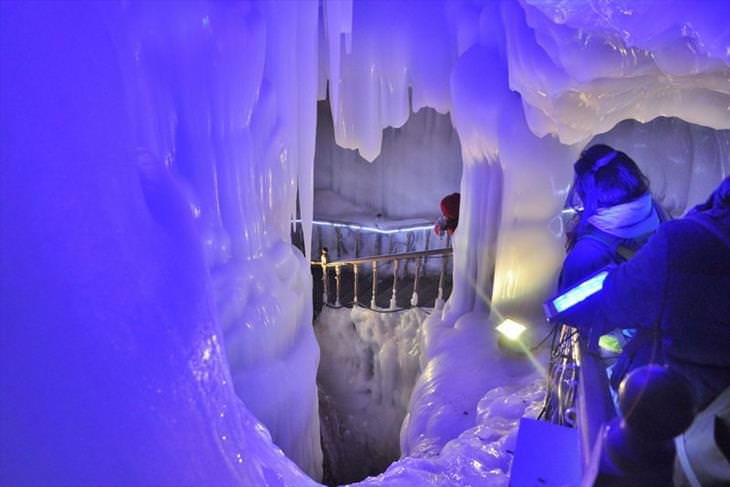On a pleasantly warm summer's day in the mountains of Shanxi Province in China, the walls and floor of Ningwu cave are covered with layers of frozen water. Ice stalactites stretch down from the ceiling, and ice stalagmites reach up from the floor, even when temperatures outside soar to the high teens. The cave is 85m deep and set into the side of a mountain more than 2,000m above sea level. Undoubtedly, the sight is dazzling, but is it unique?
Click on the images to view them in their full size
Ice caves have been an object of study for more than 150 years, but how they remain so cold has sparked controversy. Explanations have included a local reversal of geothermal heat, whereby the warm currents from Earth's hot mantle might sometimes miss a particular patch of ground, causing icy deposits if a cave of the right shape happens to be in that area.
While this may be a plausible explanation for some ice caves, scientists studying the Ningwu cave at the Chinese Academy of Geological Sciences beg to differ. Yaolin Shi points out that while geothermal heat does vary in places, these often influence surface temperatures too. Meaning that if it is colder underground because of a lack of geothermal heat, it will be colder at the surface.
Ningwu cave, however, acts differently. In this particular location, summer temperatures at the surface can reach 62°F even when the cave temperature hovers at around 32°F. Clearly, there is quite a discrepancy between the two.
The cave therefore needs to be be cooled in the first place. The cooling probably begins with the air outside the cave rather than a lack of geothermal heat below it. During the winter months, temperatures outside the cave plummet to -5°F. The cool and dense air from the outside cascades into the cave, meanwhile, the warmer air inside the cave rises up and escapes, lowering temperatures inside the cave further.
Once the ice has formed in the cave, it acts as a buffer that stabilizes the temperature. Meaning that if warmer air passes into the cave, some of the ice starts to melt. However, this takes a lot of energy, and so the formation of a little melted water, effectively absorbs most of the incoming heat, preventing the rest of the cave from warming up too much.
It turns out that the reverse is also true. When cold air pours in, any liquid water in the cave will freeze. This releases energy and stops the cave's temperature from plummeting as low as temperatures outside. To a certain extent, this process can keep temperatures quite constant in the cave. Furthermore the ice and water near the cave entrance help to even out the cave temperature throughout the year.
While the seasonal flows of air through the space play an important part on the ice cave's constant cooling temperature, it turns out that a number of combinations are also at play, including the cave's particular shape and position, as well as the nature of the heat exchange with the rock walls, creating a unique micro-environment necessary to keep the cave ice cold when the outside temperatures are nice and warm.

This spectacular cave is open to the public between May and October. It draws up to 1,000 visitors a day, with each tourist roughly spending about an hour in the cave, which is illuminated by 200 light bulbs. As one would expect, both the tourists and the bulbs give out heat, but according to Shi, this extra warmth should not disrupt the cave's environment, provided it receives a seasonal flow of cold air.
IMAGE: ZHOU JUNXIANG/IMAGINECHINA/AP
Unfortunately, many ice caves are being lost to recent climate change. Shorter winters produce less cold air, needed to replenish the ice caves, tipping them out of balance. Consequently, this has led to international and local efforts to try to preserve the caves.
IMAGE: ZHOU JUNXIANG/IMAGINECHINA/AP
IMAGE: ZHOU JUNXIANG/IMAGINECHINA/AP
IMAGE: ZHOU JUNXIANG/IMAGINECHINA/AP
IMAGE: ZHOU JUNXIANG/IMAGINECHINA/AP
Watch this video to learn more about Ningwu cave:
